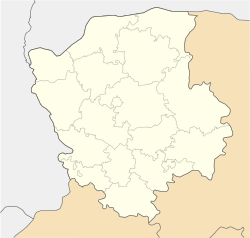Liuboml
Liuboml (Ukrainian: Любомль, romanized: Ljuboml’; Russian: Любомль, Polish and German: Luboml, Yiddish: ליבעוונע Libevne) is a town located in the western part of Ukraine, in the Volyn Oblast (province); close to the border with Poland. It serves as the administrative center of the Lyubomlskyi Raion (district). Population: 10,397 (2015 est.)[1]
- This page deals with a city in Ukraine. For the film named after this city, see Luboml (film).
Liuboml Любомль | |
|---|---|
City | |
 Skyline of Liuboml | |
 Flag  Coat of arms | |
 Liuboml  Liuboml | |
| Coordinates: 51°13′25″N 24°01′58″E | |
| Country | |
| Oblast (province) | |
| Raion (district) | Liuboml Raion |
| Government | |
| • Mayor | Roman Jushchuk |
| Elevation | 187 m (614 ft) |
| Population (2015) | |
| • Total | 10,397[1] |
Overview
Liuboml is situated 200 miles (320 km) southeast of Warsaw and 290 miles (470 km) west of Kiev, in a historic region known as Volhynia; not far from the border with Belarus to the north, and Poland to the west. Because of its strategic location at the crossroads of Central and Eastern Europe, Liuboml had a long history of changing rule, dating back to the 11th century. The territory of Volhynia first belonged to Kievan Rus', then to the Kingdom of Poland, the Polish–Lithuanian Commonwealth, the Russian Empire, interwar Poland, the USSR, and finally to sovereign Ukraine.[2]
20th century

Before the Nazi and Soviet invasions of Poland in September 1939 and the ensuing Holocaust, Luboml was the capital of an urban county in the Wołyń Voivodeship (1921–39) of the Second Polish Republic with the highest percentage of Jews anywhere in the country by 1931, exceeding 94% of the total population of over 3,300 people.[3]
In Yiddish, the town was called Libivne. During World War II, Liuboml was occupied twice. It remained under the German occupation from 25 June 1941 until 19 July 1944 in the years following the anti-Soviet Operation Barbarossa. It was administered as a part of the Nazi German Reichskommissariat Ukraine. The entire Jewish community of Liuboml was annihilated in a mass shooting action conducted in 1942 on the outskirts of town in the deadliest phase of the Holocaust. The town's Jews along with refugees from western Poland estimated at around 4,500 people, were taken by the German Einsatzgruppen aided by the local Ukrainian collaborators and Auxiliary Police to nearby pits and shot. There were 51 known survivors from the virtually eradicated town. Liuboml was repopulated during the postwar repatriations.[4]
Historical and Cultural Heritage Monuments
The town's landmarks include St. George's Church, built in the 16th century in place of a 13th-century Orthodox church which previously occupied the site, and the Trinity Church, which goes back to 1412, but was subsequently rebuilt, with a belfry from 1640. Prior to Second World War, the grand synagogue was a dominant landmark as well, before its meticulous destruction.
Gallery
.jpg) Site of Ancient Settlement with the castle hill and fosse (“Fossia”) in the city centre, XIII-XIV cent.
Site of Ancient Settlement with the castle hill and fosse (“Fossia”) in the city centre, XIII-XIV cent..jpg) Sign of Ancient Settlement of XIII-XIV cent. in the city centre
Sign of Ancient Settlement of XIII-XIV cent. in the city centre Ancient Settlement in hole “Shopy”, X cent.
Ancient Settlement in hole “Shopy”, X cent. Sign of Ancient Settlement in hole “Shopy”, X cent.
Sign of Ancient Settlement in hole “Shopy”, X cent..jpg) Saint George Church (1264), entrance view
Saint George Church (1264), entrance view.jpg) Saint George Church (1264), side view
Saint George Church (1264), side view- Kostel of the Holy Trinity (1412) with bell tower (1764), complex
- Kostel of the Holy Trinity (1412), side view
- Bell Tower (1764) of Kostel of the Holy Trinity, entrance view
.jpg) Nativity of Virgin Mary Church (wooden, 1884)
Nativity of Virgin Mary Church (wooden, 1884).jpg) Nativity of Virgin Mary Church, entrance view
Nativity of Virgin Mary Church, entrance view.jpg) Palace of polish counts Branicki (2nd half of XVIII cent)
Palace of polish counts Branicki (2nd half of XVIII cent).jpg) Palace of polish counts Branicki, back view
Palace of polish counts Branicki, back view Great Synagogue (1510) ruined in 1947
Great Synagogue (1510) ruined in 1947.jpg) Historical central square buildings (faced)
Historical central square buildings (faced).jpg) Historical market place buildings
Historical market place buildings- Statue of Bohdan Khmelnytskiy
See also
- Luboml: My Heart Remembers, a documentary film that describes Jewish life in Liuboml between the two World Wars and mourns the town's Jewish population, lost during World War II.
| Wikimedia Commons has media related to Liuboml. |
References
- "Чисельність наявного населення України (Actual population of Ukraine)" (PDF) (in Ukrainian). State Statistics Service of Ukraine. Retrieved 1 July 2016.
- From the Luboml exhibit (1999). "Luboml". Remembering Luboml — Images of a Jewish Community. Minneapolis Jewish Community Center. Homepage. Retrieved 17 September 2015.
- Andrzej Gawryszewski (2005). Distribution of Jewish population (by religion) in Poland in 1921 and 1931 (PDF). Język, narodowość, wyznanie. Warsaw: Polish Academy of Sciences. 282 (44/80 in PDF). Archived from the original on 22 November 2009. Retrieved 17 September 2015.CS1 maint: BOT: original-url status unknown (link)
- Florida Chapter of the American Society for Yad Vashem (April 26, 2006). "U.S. Students Discover Holocaust Through Short Stories of Polish Shtetl". JTA: Jewish Telegraphic Agency. Retrieved 17 September 2015.
- Luboml.org website in remembrance of the vanished Jewish community.